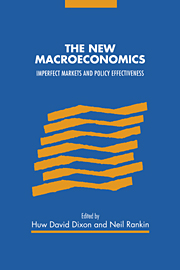Book contents
- Frontmatter
- Contents
- List of contributors
- Preface
- Acknowledgements
- Introduction
- Part I Overviews and perspectives
- 1 Classical and Keynesian features in macroeconomic models with imperfect competition
- 2 Imperfect competition and macroeconomics: a survey
- 3 Notes on imperfect competition and New Keynesian economics
- Part II Goods market imperfections
- Part III Labour market imperfections
- Part IV Financial market imperfections
- Part V Nominal rigidities and bounded rationality
- Bibliography
- Index of authors
- Index of subjects
1 - Classical and Keynesian features in macroeconomic models with imperfect competition
Published online by Cambridge University Press: 13 October 2009
- Frontmatter
- Contents
- List of contributors
- Preface
- Acknowledgements
- Introduction
- Part I Overviews and perspectives
- 1 Classical and Keynesian features in macroeconomic models with imperfect competition
- 2 Imperfect competition and macroeconomics: a survey
- 3 Notes on imperfect competition and New Keynesian economics
- Part II Goods market imperfections
- Part III Labour market imperfections
- Part IV Financial market imperfections
- Part V Nominal rigidities and bounded rationality
- Bibliography
- Index of authors
- Index of subjects
Summary
Introduction
Recent years have seen a rapidly growing development of macroeconomic models based on imperfect competition. A strong point of these models is that they are able to generate inefficient macroeconomic equilibria, obviously an important characteristic nowadays, while maintaining rigorous microfoundations. Indeed in these models both price and quantity decisions are made rationally by maximizing agents internal to the system, which thus differentiates them from Keynesian models, where the price formation process is a priori given, and also from classical (i.e. Walrasian) models, where the job of price-making is left to the implicit auctioneer.
Since for many years the macroeconomic debate has been dominated by the ‘classical versus Keynesian’ opposition, a question often posed by various authors, both inside and outside the domain, is whether these macroeconomic models with imperfect competition have more ‘classical’ or ‘Keynesian’ properties. The debate on this issue has sometimes become rather muddled and the purpose of this chapter is to give a few basic answers in a simple and expository way. This we shall do not by reviewing all contributions to the subject (there are already two excellent review articles, by Dixon and Rankin, 1994 and Silvestre, 1993), but by constructing a simple ‘prototype’ model with rigorous microfoundations, including notably rational expectations and objective demand curves, and examining how its various properties relate to those of Keynesian and classical models.
- Type
- Chapter
- Information
- The New MacroeconomicsImperfect Markets and Policy Effectiveness, pp. 15 - 33Publisher: Cambridge University PressPrint publication year: 1995
- 3
- Cited by



